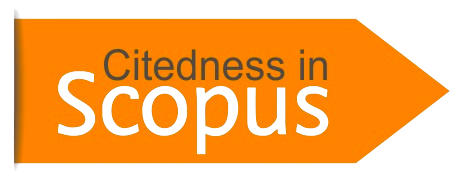HUBUNGAN ANTARA KREATIVITAS DENGAN PRESTASI BELAJAR SISWA
DOI:
https://doi.org/10.15575/psy.v4i1.2196Keywords:
verbal creativity, figural creativity, and study achievementAbstract
One of aspects that can encourage students in order to be able to get achievement in education is creativity, i.e., a mental process in which experiences in the past is recombined often with a form changed. This research is done to know the correlation between creativity and study achievement. Related to it, non-experimental with correlation method is used. Creativity is measured by using verbal and figural creativity test composed by Torrence (Munandar, 1977) with ordinal scale study achievement is measured by looking the cumulative value of student reports in the last of semester which is put into the ordinal scale. Because both the scales have interval scale, so the hypothesis test used is the formula of Pearson correlation. Based on the result of significance test, it is gotten that thitung is 1,07. With standard of significance α=0,05and (dkn-2) =44for the test of both sides, it is gotten ttabel =2.02. The criteria test used is repelling H0 if thitung is the same as or higher than ttabel. However thitung = 1,07is not higher than ttabel =2,02 on the standard of significance=0,05,therefore H0 is accepted. So, it can be said that there is no the significant positive correlation between creativity and study achievement.
References
Al-Rasyid, H. (1994). Statistika Sosial. Bandung: PPS Universitas Padjajaran
Arikunto, Suharsimi. Prof. Dr. (2000). Mana-jemen Penelitian. Jakarta: Rineka Cipta
Anderson, J.R.. (1980). Cognitive psychology and its implication, W.H. Freeman, San Francisco
Azwar, Saefuddin. (2004). Penyusunan Skala Psikologi. Yogyakarta: Pustaka Pelajar Offset
Amable.(1983).Creativity In Context. West-view Pres
Champion, D.J. (1981). Basic Statistic For Social Research. New York: Library of Congress Cataloging In Publikcatio
Chaplin, J.P. (1997). Dictionary Psuchology. New York: Dell Pub, Co Inc.
Cropley, A.J. (1967). Creativity, Edited by P.E Vernon.Penguin Education
Freidenberg, L. (1995). Psychological Testing Design, Analisis, and Use. Massa-chussest: A Simon & Schuster Company
Guilford, J.P. (1950). Intelegence, Creativity and Their Educational Implication. Ca-lifornia: Robert R. Knapp
_________,(1967).Statistic In Psychology & Education.Elexmedia Komputido
Gary. (1980). Cristian Counseling : A Com-prehensif Guide.Word Publishing
Hilgard, E.R. (1962). Introduction to Psycho-logy, 3thEdition. New York: Brace and Wardl, Inc.
Hulbect &Kinnon.(1945).â€Title V†bimbingan dan konseling.New York: Dell Pub, Co Inc.
Hurlock.E. (1978).Child Development, 6th Edi-tion. New York: Mc Graw Hill Kogakusha Ltd
Lowenfeld, V. et.all.(1975). Creative and Mental Growth, 6th Edition. New York: Mac Millan Publishing Co. Inc.
M. Surya. (1979). Disertasi, Pengaruh Faktor Non Intelektual terhadap Gejala Ber-prestasi Kurang.Yogyakarta
Munandar, S.C.U. (1992). Mengembangkan bakat dan kreatifitas anak sekolah. Ja-karta: Gramedia
________, (2004). Pengembangan Kreatifitas Anak Berbakat. Jakarta: Rineka Cipta
________, (1988). Laporan penelitian Stan-darisasi tes Kreativitas Verbal, Fakultas psikologi Universitas Indonesia Jurusan Psikologi Pendidikan
________, (1977). Creativity and Education. Direktorat Jendral Perguruan Tinggi De-partemen Pendidikan dan Kebudayaan
________,(1985).Potensi Kreativitas Anak Berbakat.Fakultas Psikologi Universitas Indonesia Jurusan Psikologi Pendidikan
Moslow.(1959).Growth Psychology Model of healthy personality.New York.
Nazir, M. (1988). Metode Penelitian. Jakarta: Ghalia Indonesia
Nasution,S (1996). Psikologi Pendidikan. Ja-karta: PT.Bumi Aksara
Renzulli, J.S. (1977). The Enrichment Triad Model: A Guide for Developing Defen-sible Programs for the Gifted and Tale-nted. Connecticut: Creative Learning Pr
Riduan Drs. M.B.A.. (2005). Skala Pengu-kuran Variabel-variabel Penelitian. Bandung: Alfabeta
Rogers C.R., (1959). Creativity, ch.13, Selected Reading, Edited by P.E. Ver-non, Penguin Education
Rhodes (1961).A Decentered Theory of Governence.New York
Sarwono, Sarlito Wirawan Prof. Dr. (2002). Teori-teori Psikologi Sosial. Jakarta: PT. Raja Grafindo Persada
Siegel, S. (1992). Statistik Nonparametrik Untuk Ilmu-Ilmu Sosial. Jakarta: PT Gramedia Pustaka Utama
Syamsudin, A.(1981). Psikologi Pendidikan. Bandung: Remaja Rosda karya
Sudjana, (2001). Metoda Statistika. Bandung: PT. Tarsito
Surya, M. (1979). Psikologi pembelajaran dan Pengajaran. Bandung: Surya pustaka
Supriadi, D. (1994). Kreatifitas, Kebudayaan dan Perkembangan Iptek. Bandung: Alfabeta
Schaeffer, C. (1971). A Common Word Bet-ween Us and You. Penguin Education
Thalib, M. (2001). Seni dan Sikap Islami Mendidik Anak. Bandung: IBS
Treffinger. (1980). Membiasakan Belajar Nyaman dan Menyenangkan. Jakarta: Gra-sindo
Wallach, M.A. (1973). Creativity, ch. 19, Selected reading, Edited by P.E. Vernon. Penguin Education
Wingkel, W.S. (2004). Psikologi Pengajaran. Jakarta: Grasindo
Winardi. (1973). Kreatifitas dan tehnik-tehnik pemikiran kreatif. Jakarta: Citra Aditya Bakti
Williams. (1975). Culture And Sociaty. Elex-media Komputindo
Witherrington. (1959). Education Pschological. Penguin Educational
Downloads
Published
Issue
Section
Citation Check
License
The author whose published manuscript approved the following provisions:
1. The right of publication of all material published in the journal / published on the E-Journal of Psychology website is held by the editorial board with the knowledge of the author (moral right remains the author of the script).
2. The formal legal provisions for access to digital articles of this electronic journal are subject to the terms of the Creative Commons Attribution-ShareAlike license (CC BY-SA), which means that the Journal of Psychology reserves the right to save, transmit media / format, manage in database form, , maintain, and publish articles without requesting permission from the Author as long as it continues to include the name of the Author as the owner of Copyright.
3. Printed and published print and electronic manuscripts are open access for any purposes. In addition to these objectives, the editorial board shall not be liable for violations of copyright law.
Â






